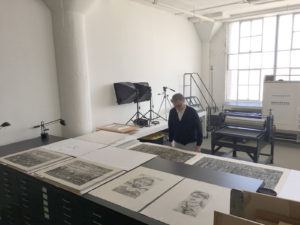
In honor of the late professor John Knudsen, I would like to offer a perspective on his printed works; a selection of lithographs, woodcuts, etchings and engravings are included in this exhibition. My remarks and observations are informed by my 40-year history as a student of print and as a student of John’s some 40 years ago.
John’s extraordinary talent as a maker of prints rivals his gifts as a painter. I contend that the prints on view are a priori to the paintings. Not to suggest that his paintings are alternatives to his prints, but rather that the prints and their technical virtuosity inform his brushwork, composition and the spatial language within the paintings. If you compare the density of information found in both the paintings and the prints, you will begin to notice a visual syntax they share, almost literal examples of this.
It’s no surprise to find that John was an avid collector and aficionado of fine rugs and woven textiles. So much so that he could make an example (rug) that experts found convincing, if not perfect.
We may now know the inspiration john’s eye found in his passion for rug.However, the figurative subject matter of his art is at the core of his Intention: to depict the human condition as a flawed, riotous pattern. He focused on the urban environment, with its dense topography and primary palette, and rendered it as a metaphor, a pattern. At first glance it may seem that he rendered it brick by brick, line by line as a facsimile. Yet, if you look closer in the larger cityscape paintings, and even less in the engravings of the same subject. Our eyes read these pictures as an overall pattern, and then rest by focusing on isolated passages to find the threads of a story(line). In the prints, sometimes the smallest statement is the most grand. It is in the minutiae; that is where the big picture is revealed.
Prints are fundamentally about minutiae. John’s prints contain many tour-de-force passages of subtle chiaro-scuro, engraved line and aquatint. This technical facility was a by-product of his education as a student of the late Argentinean master of intaglio printmaking, Mauricio Lasansky, Lasansky taught John at the University of Iowa, in the first studio program in the United States to offer a Masters of Fine Arts in printmaking and the understanding that it is a noble and valued endeavor. As John’s student, I was taught in the same way - to learn from the tradition of print, and then take it somewhere new and express a personal vision.
Pay particular attention to the chronology of the prints. You can see the evolution of his particular style. Along the way we find references to the engraved lines of Durer, the drypoints of Picasso, the ragged, carved wood excavations in a Gauguin, the delicate etched lines and aquatints of Chagall, and the wandering lithographic line and forms of Dubuffet. In the end all I see is the phenomenal talent of John Knudsen. That is the ultimate goal of any artist seeking truth and personal clarity with his art.
In summation, my short education with John left me with a perspective on print and what a real artist can do with the print processes. John always insisted on making art in a context of tradition. With this exhibition you will experience a small sampling of his humanity and talent. Harper College, the institution where John established a tradition of excellence and taught so many, has now brought his genius back home in thes much deserved tribute. Those who knew him are grateful for the opportunity to sing his praises and remember him so fondly.
Thomas Cvikota is a contemporary art consultant, publisher and owner of ETC Industries - C. Editions.
